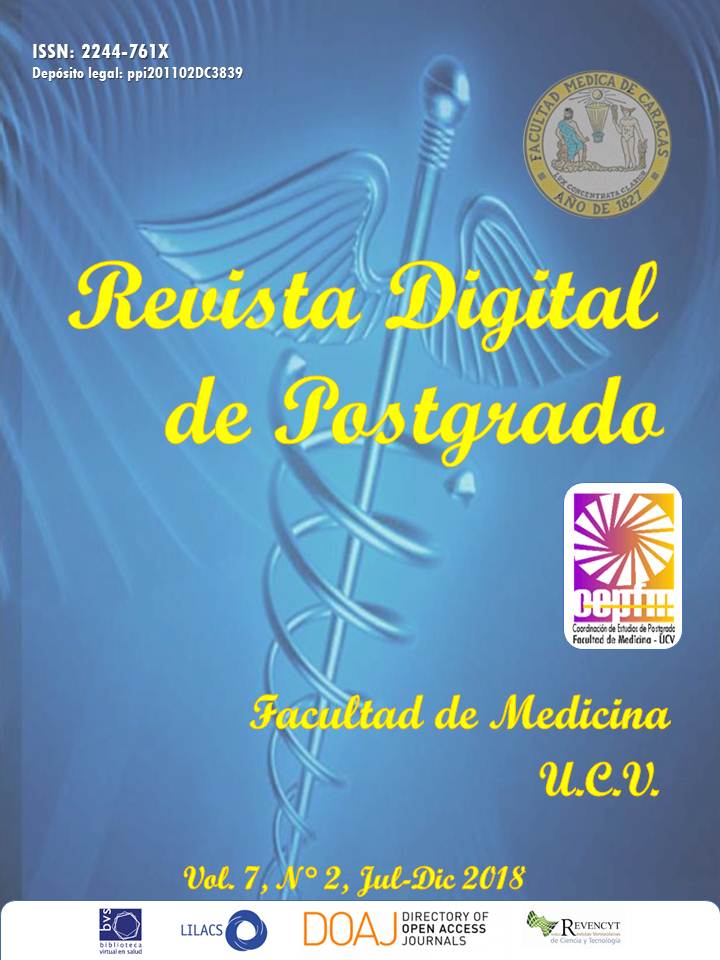Taponamiento cardíaco por retiro de electrodo epicárdico posterior a cirugía cardíaca
Palabras clave:
Electrodo epicárdico transitorio, Taponamiento cardiaco, Marcapaso epicárdicos.Resumen
Se presenta un caso de Taponamiento Cardíaco como complicación por retiro de electrodo epicárdico posterior a cirugía cardiaca. Se describe el caso de un paciente masculino de 55 años sometido a cirugía de revascularización miocárdica sin circulación extracorpórea. El postoperatorio inmediato transcurrió sin incidencias, siendo extubado a las 6 horas de la llegada a la unidad de cuidados intensivos (UCI). No requirió uso de inotrópicos ni hemoderivados. Ninguna alteración electrocardiográfica. A las 72 horas se retiraron los tubos de drenaje, así como el electrodo de estimulación transitoria ventricular epicárdico. A las dos horas el paciente comenzó a inestabilizarse hemodinámicamente. Mediante ecocardiografía transtorácica se evidenció un hematoma que comprimía la cara anterior de ventrículo derecho. Requirió exploración quirúrgica, reapertura esternal encontrando sangrado activo correspondiente al área de implante del electrodo epicárdico transitorio. La evolución posterior fue satisfactoria y el paciente fue dado de alta hospitalaria a los tres días siguientes. Los electrodos transitorios de estimulación cardiaca (ETEC) como el epicárdico, son usados en exceso en cirugía cardíaca y no están exentos de graves y fatales complicaciones. La cirugía coronaria sin circulación extracorpórea podría ofrecer una oportunidad para seleccionar adecuadamente a aquellos pacientes que van a necesitar estimulación cardíaca postoperatoria. Estudios prospectivos aleatorizados son necesarios para poder precisar los pacientes que realmente se beneficiarían de usar marcapasos epicárdicos transitorios.
Descargas
Citas
Harris PD, Malm JR, Bowman Jr FO, Hoffman BF, Kaiser GA, Singer DH. Epicardial pacing to control arrhythmias following cardiac surgery. Circulation. 1968; 37(4 Suppl):II178-83.
Mishra P, Lengyela E, Lakshmanan S, Luckraz H. Temporary epicardial pacing wire removal: Is it an innocuous procedure? Interact Cardiovasc Thorac Surg. 2010;11(6):854.
Imren Y, Benson AA, Oktar G, Cheema F, Comas G, Naseem T. Is use of temporary pacing wires following coronary bypass surgery really necessary? J Cardiovasc Surg. 2008;49:261-7.
Ragaza EP, Low HBC, Shapiro RL. Pericardial effusion with resultant right hemothorax after removal of epicardial pacing wires. J Thorac Cardiovasc Surg. 1973;66:814-6.
Reade MC. Temporary epicardial pacing after cardiac surgery: a practical review. Part 1: General considerations in the management of epicardial pacing. Anaesthesia. 2007;62:264.
Maisel WH, Epstein AE. The role of cardiac pacing. American College of Chest Physicians guidelines for the prevention and management of postoperative atrial fibrillation after cardiac surgery. Chest. 2005;128: 36S-8S.
Del Nido P, Goldman BS. Temporary epicardial pacing after open heart surgery: complications and prevention. J Card Surg. 1989;4(1):99-103.
Bethea BT, Salazar JD, Grega MA, Doty JR, Fitton TP, Alejo DE, et al. Determining the utility of temporary pacing wires after coronary artery bypass surgery. Ann Thorac Surg. 2005;79:104.
Fishberger S, Rossi A, Bolivar J, Lopez L, Hannan R, Burke R. Congenital cardiac surgery without routine placement of wires for temporary pacing. Cardiol Young. 2008;18:96–9.
Puskas JD, Sharoni E, Williams WH, Petersen R, Duke P, Guyton RA. Is routine use of temporary epicardial pacing wires necessary after either OPCAB or conventional CABG/CPB? Heart Surg Forum. 2003;6(6): E103
Murphy P, Morton P, Murtagh JG, Scott M, O’Keeffe B. Haemodynamic effects of different temporary pacing modes for the management of bradycardias complicating acute myocardial infarction. Pacing Clin Electrophysiol. 1992;15:391-6.
Nishimura RA, Hayes DL, Ilstrup DM, Holmes DR, Tajik AJ. Effect of dual-chamber pacing on systolic and diastolic function in patients with hypertrophic cardiomyopathy: Acute Doppler echocardiographic and catheterization hemodynamic study. J Am Coll Cardiol. 1996;27:421-30.
Gammage MD. Temporary cardiac pacing. Heart. 2000;83:715-20.
Antman EM, Anbe DT, Armstrong PW, Bates ER, Green LA, Hand M, et al. ACC/AHA guidelines for the management of patients with ST-elevation myocardial infarction: a report of the American College of Cardiology/American Heart Association Task Force on Practice Guidelines (Committee to Revise the 1999 Guidelines for the Management of Patients with Acute Myocardial Infarction). Circulation. 2004;110:e82-292.
Braun MU, Rauwolf T, Bock M, Kappert U, Boscheri A, Schnabel A, et al. Percutaneus lead implantation connected to an external device in stimulation-dependent patients with systemic infection- A prospective and controlled study. Pace. 2006;29:875-9.
Cock C, Van Campen L, Visser C. Usefulness of a new activefixation lead in transvenous temporary pacing for femoral approach. Pace. 2003;26:849-52.
Hynes JK, Colmes DR, Harrison CE. Five-year experience with temporary pacemaker therapy in the coronary care unit. Mayo Clin Proc. 1983;58:122-6.
Murphy JJ. Current practice and complications of temporary transvenous cardiac pacing. BMJ. 1996;312:1134.
López Ayerbe J, Villuendas Sabaté R, García García C, Rodríguez Leor O, Gómez Pérez M, Curós Abadal A, et al. Marcapasos temporales: utilización actual y complicaciones. Rev Esp Cardiol. 2004;57:1045-52.
Zoll PM. Resuscitation of the heart in ventricular standstill by external electrical stimulation. N Engl J Med. 1952;248:768-71.
Falk RH, Zoll PM, Zoll RH. Safety and efficacy of noninvasive cardiac pacing. A preliminary report. N Engl J Med. 1983;309:1166-9.
Zoll PM, Zoll RH, Falk RH, Clinton JE, Eitel DR, Antman EM. External noninvasive temporary cardiac pacing: clinical trials. Circulation. 1985;71:937-44.
Zakhia Doueihi R, Leloux MF, De Roy L, Kremer R. Permanent cardiac pacing for prolonged second and third degree atrioventricular block complicating cardiac valve replacement. Circulation. 1968;38:1044-59.
Batra AS, Wells WJ, Hinoki KW, Stanton RA, Silka MJ. Late recovery of atrioventricular conduction after pacemaker implantation for complete heart block associated with surgery for congenital heart disease. J Thorac Cardiovasc Surg. 2003;125:1291-3.
Kikura M, Sato S. The efficacy of preemptive Milrinone or Amrinone therapy in patients undergoing coronary artery bypass grafting. Anesth Analg. 2002;94:22-30.
Panescu D, Webster JG, Stratbucker RA. Modeling current density distributions during trasncutaneos cardiac pacing. IEEE Trans Biomed Eng. 1994;41:549-55.
Hancock EW. AV block after aortic valve replacement. Hosp Pract (Off Ed). 1988;23:41-45.
Descargas
Cómo citar
Número
Sección
Licencia
Usted es libre de:
- Compartir — copiar y redistribuir el material en cualquier medio o formato
- Adaptar — remezclar, transformar y construir a partir del material
- para cualquier propósito, incluso comercialmente.
Bajo los siguientes términos:
-
Atribución — Usted debe dar crédito de manera adecuada, brindar un enlace a la licencia, e indicar si se han realizado cambios. Puede hacerlo en cualquier forma razonable, pero no de forma tal que sugiera que usted o su uso tienen el apoyo de la licenciante.
- No hay restricciones adicionales — No puede aplicar términos legales ni medidas tecnológicas que restrinjan legalmente a otras a hacer cualquier uso permitido por la licencia.














